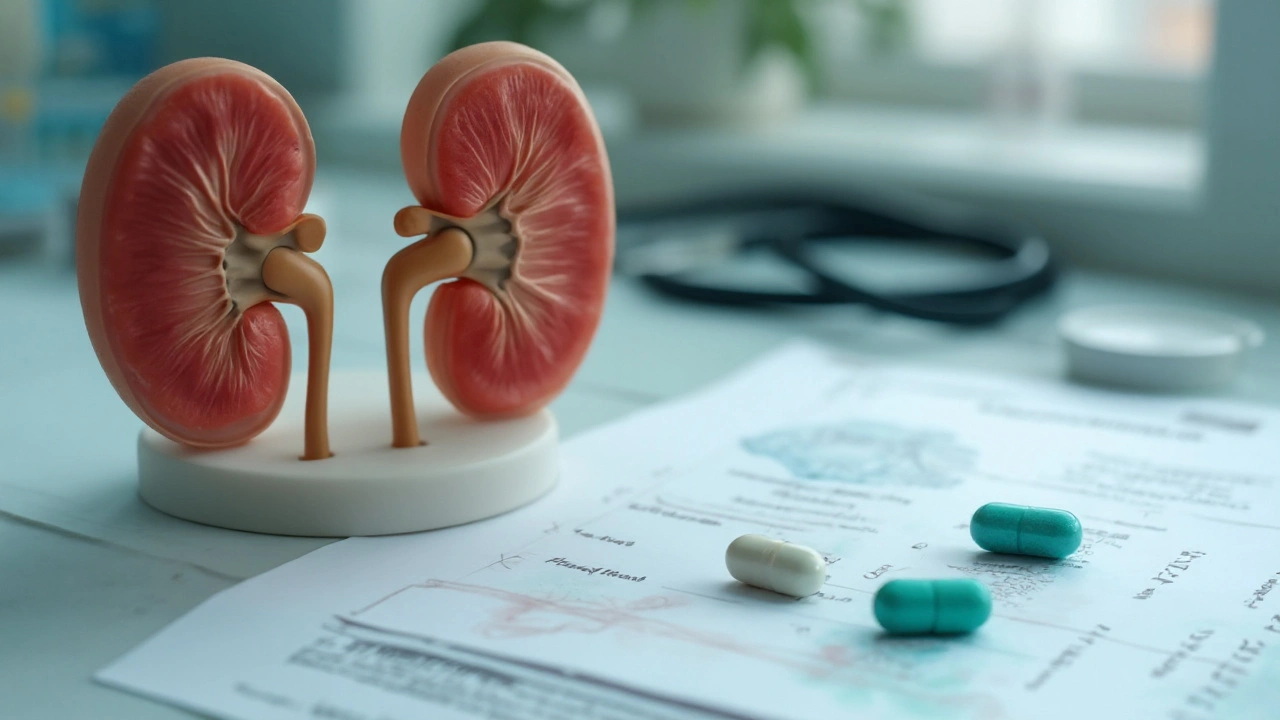Diuretic Choice Advisor
Enter your patient's clinical details below to get personalized diuretic recommendation:
Hydrochlorothiazide is a thiazide‑type diuretic that promotes sodium and water excretion, lowering blood pressure and reducing fluid overload. It’s been a first‑line option for uncomplicated hypertension for decades, but a growing body of evidence shows that other agents may outperform it in certain patients. This guide walks you through the key differences, helping you decide when to stick with HCTZ and when to switch to an alternative.
How Hydrochlorothiazide Works
Hydrochlorothiazide (HCTZ) blocks the Na⁺/Cl⁻ symporter in the distal convoluted tubule. By preventing sodium reabsorption, it creates an osmotic gradient that pulls water into the urine. The resulting volume contraction triggers the renin‑angiotensin‑aldosterone system (RAAS), which modestly raises renin levels but still produces a net drop in systolic and diastolic pressure. Typical reductions are 8‑10mmHg for systolic values in untreated patients.
Clinical Situations Where HCTZ Shines
- Low‑to‑moderate risk hypertension: In patients with stage1 hypertension and no major comorbidities, HCTZ delivers adequate control with a simple once‑daily dose.
- Edema from heart failure or cirrhosis: Its modest diuretic effect can complement loop diuretics for fluid overload.
- Cost‑sensitive settings: Generic HCTZ costs pennies per tablet, making it the most affordable prescription diuretic worldwide.
Despite these strengths, HCTZ has notable drawbacks that have prompted clinicians to look at alternatives.
Why Look at Alternatives?
Three recurring themes drive the shift: potency, duration of action, and electrolyte safety. In head‑to‑head trials, newer thiazide‑like agents such as chlorthalidone and indapamide produce greater blood‑pressure reductions and carry a lower risk of hypokalemia. Loop diuretics like furosemide are preferred when rapid, high‑volume diuresis is needed, while potassium‑sparing agents such as spironolactone help counteract the potassium loss that thiazides can cause.
Side‑Effect Profile Comparison
All diuretics touch kidney function and electrolytes, but the magnitude varies. Below is a quick snapshot:
| Agent | Typical Daily Dose | Half‑life (hrs) | Sodium Reduction % | Hypokalemia Risk | Preferred Indication |
|---|---|---|---|---|---|
| Hydrochlorothiazide | 12.5-50mg | 6-15 | ≈25% | Medium | Stage1 HTN, mild edema |
| Chlorthalidone | 12.5-25mg | 40-60 | ≈35% | Low‑to‑Medium | Resistant HTN, chronic kidney disease |
| Indapamide | 1.5mg | 14-18 | ≈30% | Low | Ischemic heart disease, HTN with metabolic syndrome |
| Furosemide | 20-80mg (or IV bolus) | 2-4 | ≈50% | High (including hypokalemia, hyponatremia) | Acute pulmonary edema, severe HF |
| Spironolactone | 25-100mg | 13-15 | ≈10% | Very low (potassium‑sparing) | Hyperaldosteronism, add‑on for resistant HTN |
The table highlights three practical takeaways. First, chlorthalidone’s long half‑life steadies blood‑pressure control over 24hours, often eliminating the need for a separate nighttime dose. Second, indapamide’s neutral effect on potassium makes it a good match for patients already on ACE inhibitors or ARBs. Third, furosemide’s rapid action is unmatched for acute fluid removal, but its electrolyte swing demands close monitoring.
When to Swap Hydrochlorothiazide for Chlorthalidone
Guidelines from the American College of Cardiology (ACC) and the European Society of Cardiology (ESC) now list chlorthalidone as the preferred thiazide‑type diuretic for most hypertensive patients because it lowers systolic pressure an extra 3-4mmHg on average. Consider a switch when:
- Blood‑pressure targets remain unmet after maximized HCTZ dose.
- Patient has chronic kidney disease (eGFR 30‑60mL/min) and needs a more potent natriuretic effect.
- There’s a history of hypokalemia despite potassium supplementation.
Typical conversion is 25mg of HCTZ to 12.5mg of chlorthalidone. Titrate slowly and re‑measure electrolytes after one week.

Indapamide for Metabolic‑Friendly Hypertension
Indapamide is often branded as “the metabolic‑friendly thiazide.” It contains a neutral‑size carbonic anhydrase inhibitor moiety, which blunts the rise in insulin resistance sometimes seen with HCTZ. Trials in patients with type2 diabetes showed a 15% lower rate of new‑onset microalbuminuria compared with HCTZ. Choose indapamide when:
- Patient has diabetes or metabolic syndrome and you want to avoid worsening glucose control.
- Long‑term therapy is planned (its once‑daily dosing aligns with circadian BP patterns).
Start at 1.5mg extended‑release; most patients stay on that dose for years.
Furosemide for Acute Volume Overload
When a patient presents with pulmonary edema, acute decompensated heart failure, or severe renal colic, the speed of diuresis matters more than the subtle blood‑pressure tweak. Furosemide inhibits the Na⁺‑K⁺‑2Cl⁻ transporter in the thick ascending limb, forcing up to 4L of urine in the first 24hours. It’s the go‑to drug for rapid decongestion, but you must watch for:
- Sharp drops in potassium, magnesium, and calcium.
- Potential ototoxicity at high IV rates.
- Intravascular volume depletion leading to prerenal azotemia.
Because of these risks, furosemide is rarely used as first‑line for uncomplicated hypertension.
Spironolactone as a Potassium‑Sparing Add‑On
Spironolactone blocks aldosterone receptors, reducing sodium reabsorption while conserving potassium. It’s especially useful in resistant hypertension (failure of three drugs, including a diuretic). Studies like PATHWAY‑2 show a 24‑mmHg drop in systolic pressure when spironolactone is added to a thiazide regimen. However, watch for hyperkalemia in patients with eGFR<30mL/min or those already on ACE inhibitors/ARBs.
Practical Checklist for Switching Diuretics
- Confirm the indication: hypertension, edema, or both.
- Review renal function (eGFR) and baseline electrolytes.
- Select the alternative based on potency, half‑life, and electrolyte profile.
- Calculate an equivalent dose (e.g., 50mg HCTZ ≈ 25mg chlorthalidone).
- Educate the patient on possible side effects-especially dizziness from volume depletion.
- Schedule a follow‑up lab panel at 1week, then at 1month.
- Adjust concomitant drugs (ACE inhibitors, ARBs, potassium supplements) as needed.
Related Concepts Worth Exploring
Understanding diuretics fits into a larger picture of cardiovascular risk management. You may also want to read about:
- RAAS blockade: How ACE inhibitors and ARBs interact with thiazides.
- Blood‑pressure monitoring: Home cuff vs ambulatory monitoring for titration.
- Electrolyte stewardship: Strategies to prevent hypokalemia without over‑supplementation.
- Lifestyle adjuncts: Sodium restriction, weight loss, and exercise impact on diuretic efficacy.
Bottom Line
If you’re treating a straightforward, low‑risk hypertensive patient and cost is a factor, Hydrochlorothiazide still does the job. But for anyone who needs stronger pressure lowering, better potassium handling, or a longer‑acting effect, switching to chlorthalidone or indapamide is a evidence‑backed move. Reserve furosemide for rapid fluid removal and add spironolactone when three‑drug regimens fail. The key is matching the drug’s pharmacology to the patient’s clinical profile and monitoring labs closely.

Frequently Asked Questions
What makes chlorthalidone more effective than Hydrochlorothiazide?
Chlorthalidone has a longer half‑life (40‑60hrs) and a stronger natriuretic effect, which steadies blood‑pressure control over 24hours. Clinical trials show an additional 3‑4mmHg systolic drop compared with equal doses of Hydrochlorothiazide.
Can I use Hydrochlorothiazide if I have mild kidney disease?
Yes, but dose‑adjustment may be needed once eGFR falls below 30mL/min. Monitoring potassium and sodium is crucial because reduced renal clearance can amplify electrolyte shifts.
Is indapamide safe for diabetic patients?
Indapamide is considered more “metabolic‑friendly” because it has a minimal impact on glucose tolerance and insulin resistance. It’s often the preferred thiazide‑like agent for patients with type2 diabetes.
When should I add spironolactone to a thiazide regimen?
Add spironolactone when three antihypertensive agents (including a diuretic) fail to reach target BP. It works especially well in resistant hypertension by counteracting aldosterone‑mediated sodium retention.
What lab tests should I order after switching diuretics?
Check serum electrolytes (Na⁺, K⁺, Cl⁻, Mg²⁺), creatinine/eGFR, and blood urea nitrogen. Repeat these labs at 1week and again at 1month to catch early shifts.



Steven Macy
September 25, 2025 at 23:18Hydrochlorothiazide remains a solid first‑line choice for many patients with uncomplicated hypertension. It’s inexpensive, once‑daily, and works well for those without significant comorbidities. However, the longer‑acting thiazide‑like agents often give you a few extra millimetres of mercury, which can matter when you’re chasing a target. If your patient tolerates HCTZ without electrolyte issues, there’s no urgent need to switch. Keep an eye on potassium and consider a baseline kidney panel.
Jamie Hogan
October 7, 2025 at 13:05Sure but the nuance is lost in a plain summary
Ram Dwivedi
October 19, 2025 at 02:52When you look at the big picture, the choice of diuretic often reflects a balance between efficacy, safety, and patient lifestyle 😊
Hydrochlorothiazide is cheap and familiar, which makes it a convenient starting point for many clinicians.
Yet its shorter half‑life can result in a “mid‑day dip” in blood pressure control for some patients, especially those with a high salt intake.
Chlorthalidone’s extended duration smooths out those peaks and troughs, offering a more consistent 24‑hour effect.
Indapamide adds a metabolic advantage; it tends to preserve insulin sensitivity better than HCTZ, making it a thoughtful option for diabetic or pre‑diabetic individuals.
Furosemide, on the other hand, shines in acute volume overload scenarios where rapid diuresis is necessary, but its electrolyte swings demand close monitoring.
Spironolactone’s potassium‑sparing nature can counteract the hypokalemia often seen with thiazides, and it has a solid evidence base as an add‑on for resistant hypertension.
From a cost perspective, HCTZ still wins hands down, especially in resource‑limited settings where generic availability matters.
However, the long‑term cardiovascular outcomes associated with chlorthalidone have nudged several guidelines to list it as the preferred thiazide‑type agent.
For patients with chronic kidney disease, the enhanced natriuretic effect of chlorthalidone can help preserve residual renal function while still lowering blood pressure.
When prescribing, consider the patient’s electrolyte profile – a high‑risk hypokalemia patient might benefit from indapamide or a low‑dose spironolactone adjunct.
Adherence is another practical factor; a once‑daily nighttime dose of chlorthalidone can improve compliance compared to a split‑dose regimen.
Don’t forget drug interactions – thiazides can amplify the glucose‑raising effect of corticosteroids, so monitor blood sugars closely.
Overall, think of diuretic selection as a personalized algorithm that weighs the clinical scenario, patient preferences, and economic constraints 🚀
In short, start simple with HCTZ for low‑risk patients, but be ready to switch to a thiazide‑like or potassium‑sparing agent as the clinical picture evolves.
Michael Waddington
October 30, 2025 at 15:38Honestly the whole HCTZ hype is a relic; anyone still pushing it is stuck in the 90s. The drug’s half‑life is laughably short and you’ll see blood pressure rebound by lunch. If you want real control, pull the trigger on chlorthalidone and stop babysitting your patients with weak meds. The data is out there, stop cherry‑picking.
HAMZA JAAN
November 11, 2025 at 05:25Look, it’s almost comical how often clinicians cling to the cheapest pill without checking the numbers. HCTZ may be cheap, but cheap doesn’t always mean effective, especially when patients keep coming back with uncontrolled numbers. Maybe it’s time to admit the old habit isn’t working and give the newer agents a try.
April Rios
November 22, 2025 at 19:12From a pharmacological standpoint, the distinction between thiazide and thiazide‑like diuretics lies primarily in their pharmacokinetics and electrolyte handling. Chlorthalidone’s longer half‑life translates into a more sustained natriuretic effect, which has been correlated with a modest but statistically significant reduction in cardiovascular events in meta‑analyses. Indapamide’s neutral effect on potassium makes it an attractive adjunct to ACE inhibitors. Moreover, the risk‑benefit calculus shifts when you factor in comorbidities like diabetes, where HCTZ’s potential to exacerbate insulin resistance becomes clinically relevant. Therefore, the blanket recommendation of HCTZ as first‑line warrants nuanced reconsideration.
byron thierry
December 4, 2025 at 08:58Dear colleagues, I would like to extend my appreciation for the comprehensive overview provided. The inclusion of both efficacy data and practical considerations such as cost and patient adherence reflects a holistic approach to hypertension management. It is also noteworthy how the guide acknowledges regional variations in drug availability, which is essential for global practice. Thank you for facilitating a balanced discourse.
bob zika
December 15, 2025 at 22:45Excellent presentation; the tables are particularly helpful; the comparison of half‑life and electrolyte risk is crystal‑clear.; I especially value the conversion guidelines provided for HCTZ to chlorthalidone.; This resource will undoubtedly aid clinicians in making evidence‑based decisions.;
M Black
December 27, 2025 at 12:32Yo this guide is fire! love the quick table and the emoji vibes 😎 lets get those patients on the right diuretic and crush those numbers!
Sidney Wachira
January 8, 2026 at 02:18Seriously, if you’re still stuck on HCTZ after reading this, you might be living under a rock 🙄 the evidence is crystal clear, switch it up!